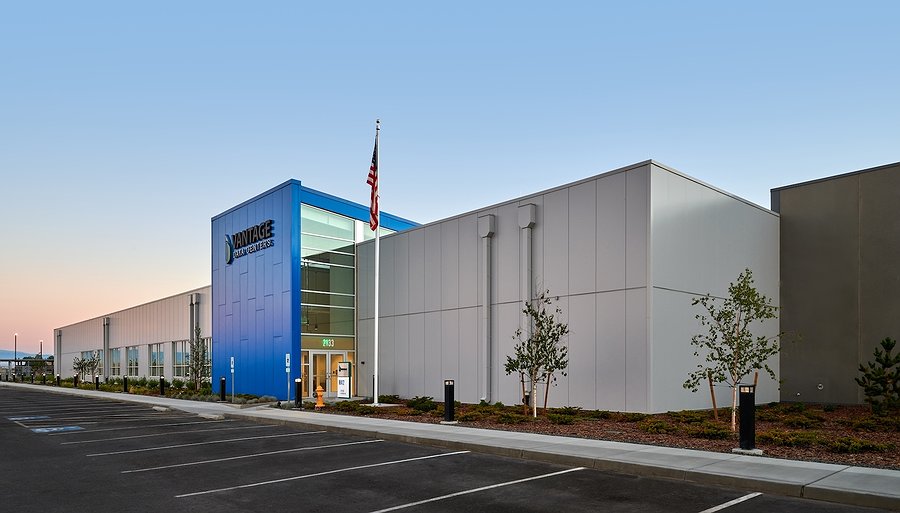Vantage Data Centers finishes 3rd phase at Quincy facility
QUINCY — There’s an old saying in real estate, that what really matters is location. Then location, and then location. The same is true of a data center.
Simon Casey, vice president of construction for Vantage Data Centers, said the data speeding along those fiber lines is subject to certain laws of physics.
“The interesting thing about data is the longer distance it travels, believe it or not, there are incremental drops in speed. It might only be nanoseconds, but for our customers and our customers’ customers that becomes really important,” Casey said.
As a result, data centers are built where they can supply customers with fast response. Vantage Data Centers, based in Denver, Colorado, recently finished the buildout of its facility in Quincy. Vantage officials cut the ribbon on the third phase in October.
Demand for data transmission, storage and management is growing, and that means companies are expanding to keep up.
“You’ll find that, insofar as we’re building data centers for our customers, our customers are also building data centers very close by,” Casey said.
“I won’t name any names, but there are several data centers under construction close to Pangborn Airport (in East Wenatchee). Those may be similar customers that we might do business with, depending on the geographical location. So really, customers are looking for both resilience and latency in their network designs. So we tend to work with our customers and make sure that we are building sites most appropriate to our customers’ needs,” Casey said.
Vantage first bought land in the Quincy area in 2011, finishing the first phase of its facility in 2013. Quincy has attracted a lot of data center business, for reasons ranging from geological stability to affordable electricity and a reliable fiber network. Quincy also has a motivated and reliable workforce, Casey said.
The third phase added 530,000 square feet to the facility, bringing its total size to 775,000 square feet. The total capacity of the facility is 89 megawatts, with the third phase at 64 megawatts.
The building opened in October, called WA 13, is occupied by one customer, Casey said. The third phase took about 15 months to build, including design.
A data center represents an evolution in how businesses and individuals use technology, even as the technology changes.
“Originally every corporation in the world used to have their servers in their own IT room, or they had some other way of housing all their electronics equipment. Now everyone is posting on the cloud. The cloud is really data centers,” he said.
“So we’ve got clusters of these buildings all over the world. Some of them are colocation, which is really how Vantage started. So you have a large building or a small building, and you have a multitude of different companies that have their computer servers inside those buildings. Via fiber connections they pass that data out to the outside world,” Casey said. “The difference with Vantage is that we’re deploying buildings on a vast scale. And now we’re at the point where we have single-user buildings.”
Demand has not only grown, it’s also changed, he said.
“We really saw a ramp up in data activity, with COVID, online shopping, software as a service. Business transactions increased exponentially over the last five years. And then within (about) the last 12 to 18 months, we’ve seen this new thing called AI start to come up. And really, that’s where a lot of industries are putting substantive investment. And that requires a lot more computing power to run all those applications that everyone is looking into. So that’s kind of the evolution,” Casey said.
What data center customers are looking for is a system that works, day or night, winter or summer, and simultaneously can accommodate various customers doing various tasks. The key is reliability, he said, and the facility has to be designed to be ready anytime the customer needs it.
As a result, the design has to take into account the location - and in this case Quincy gets pretty hot in the summer, pretty cold in the winter, and it’s desert so it’s dry.
“There’s a lot of proprietary technology within our data centers, both from an electrical and mechanical perspective,” he said.
He cited cooling requirements as one example.
“Obviously there’s a lot of heat generated off computer servers inside the building, and that’s something that you’re working to keep cool at all times,” Casey said.
An uninterruptible power supply also is crucial, which is why data centers have backup generators on-site, he said.
“When we’re building a data center, we’re building it knowing that we have almost 100% guarantee that nothing will fail in the building. And that’s because of our redundant systems or backup in places, our safety devices, these buildings will not go down in our facility and that’s why we have the reliability and the trust of our global customers.” Casey said.
Cheryl Schweizer can be reached via email at [email protected].




